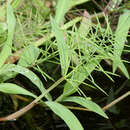Comprehensive Description
provided by North American Flora
Paspalum mucronatum Muhl. Cat. 8. 1813 ; Descr
Gram. 96. 1817.
Paspalum paniculatum Walt. Fl. Car. 75. 1788. Not P, paniculaium I^. 1759. Ceresiafluitans EHBot. S. C. & Ga. 1 : 109. 1816. Paspalum natans Le Conte, Jour, de Phys. 91 : 285. 1820. Paspalum Jlui tans Kunth, R^v. Gram. 24. 1829. Paspalum Frankii Steud. Syn. Gram. 19. 1854.
A branched floating or creeping grass, commonly rooting at the lower nodes, with broad flat leaf-blades, inflated leaf-sheaths, and numerous racemes disposed in panicles. Stems 1-several dm. long, generally stout, sometimes slender, glabrous, compressed, the nodes hirsute; leaf-sheaths much inflated, commonly strongly papillose-hirsute with spreading hairs, usually overlapping, compressed; blades 8-30 cm. long, 6-25 mm. wide, flat, glabrous, rough, narrowed at both ends; inflorescence exserted at maturity, commonly 1-2 dm. long; racemes 20-100, scattered, or sometimes apparently whorled, 1-13 cm. long, slender, spreading, the rachis membranous, 1-2 mm. wide, the apex acute, extending beyond the spikelets; spikelets singly disposed in two rows, elliptic, 1.2-1.5 mm. long and about 0.6 mm. wide, pubescent.
Type locality : Georgia,
Distribution : Virginia to Oklahoma, and south to Florida and Mexico.
- bibliographic citation
- George Valentine Nash. 1912. (POALES); POACEAE (pars). North American flora. vol 17(2). New York Botanical Garden, New York, NY
Physical Description
provided by USDA PLANTS text
Annuals, Aquatic, growing in or on water, Aquatic, leaves floating on surface, Aquatic, fresh water, Terrestrial, not aquatic, Stems trailing, spreading or prostrate, Stems nodes swollen or brittle, Stems erect or ascending, Stems geniculate, decumbent, or lax, sometimes rooting at nodes, Stems terete, round in cross section, or polygonal, Stem nodes bearded or hairy, Stem internodes solid or spongy, Stems with inflorescence less than 1 m tall, Stems with inflorescence 1-2 m tall, Stems, culms, or scapes exceeding basal leaves, Leaves mostly cauline, Leaves conspicuously 2-ranked, distichous, Leaves sheathing at base, Leaf sheath mostly open, or loose, Leaf sheath hairy, hispid or prickly, Leaf sheath and blade differentiated, Leaf sheath enlarged, inflated or disten ded, Leaf blades lanceolate, Leaf blades 1-2 cm wide, Leaf blades mostly flat, Leaf blades mostly glabrous, Leaf blades scabrous, roughened, or wrinkled, Ligule present, Ligule an unfringed eciliate membrane, Inflorescence terminal, Inflorescence solitary, with 1 spike, fascicle, glomerule, head, or cluster per stem or culm, Inflorescence a panicle with narrowly racemose or spicate branches, Inflorescence branches more than 10 to numerous, Inflorescence branches 1-sided, Rachis dilated, flat, central axis to which spikelets are attached, Rachis winged, Flowers bisexual, Spikelets pedicellate, Spikelets dorsally compressed or terete, Spikelet less than 3 mm wide, Spikelets with 1 fertile floret, Spikelets with 2 florets, Spikelet with 1 fertile floret and 1-2 sterile florets, Spikelets paired at rachis nodes, Spikelets all alike and fertille, Spikelets bisexual, Inflorescence disarticulating between nodes or joints of rachis, rachis fragmenting, Spikelets disarticulating belo w the glumes, Inflorescence branches deciduous, falling intact, Spikelets secund, in rows on one side of rachis, Rachilla or pedicel glabrous, Glumes present, empty bracts, Glumes 1 clearly present, the other greatly reduced or absent, Glumes distinctly unequal, Glumes equal to or longer than adjacent lemma, Glume equal to or longer than spikelet, Glumes 3 nerved, Lemma similar in texture to glumes, Lemma 3 nerved, Lemma glabrous, Lemma apex truncate, rounded, or obtuse, Lemma awnless, Lemma straight, Palea present, well developed, Palea shorter than lemma, Stamens 3, Styles 2-fid, deeply 2-branched, Stigmas 2, Fruit - caryopsis, Caryopsis white.
Paspalum repens: Brief Summary
provided by wikipedia EN
Paspalum repens, known as horsetail paspalum or water paspalum, is a species of grass native to South America, Central America, and North America. It is often called Paspalum fluitans, though this name is treated as a synonym of P. repens in Kew's Plants of the World Online database and the Flora of North America project.
- license
- cc-by-sa-3.0
- copyright
- Wikipedia authors and editors

